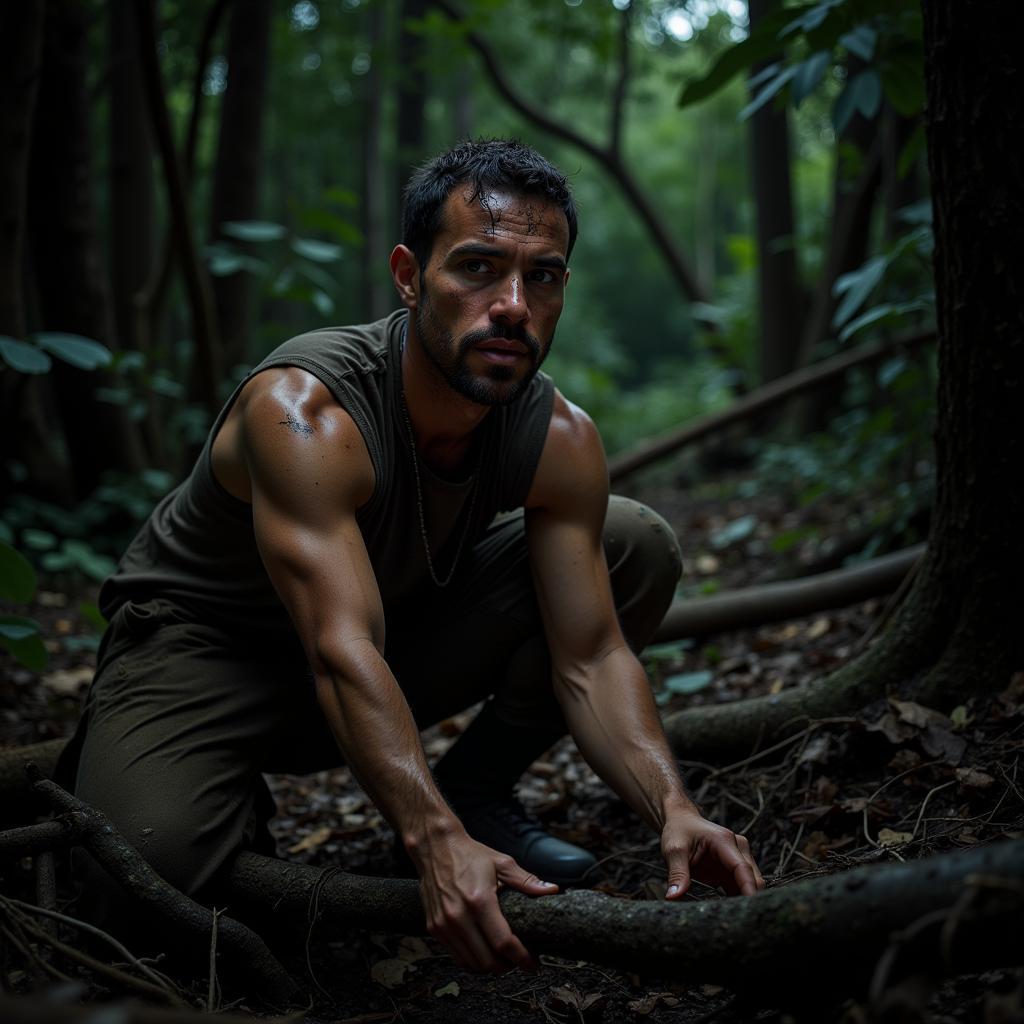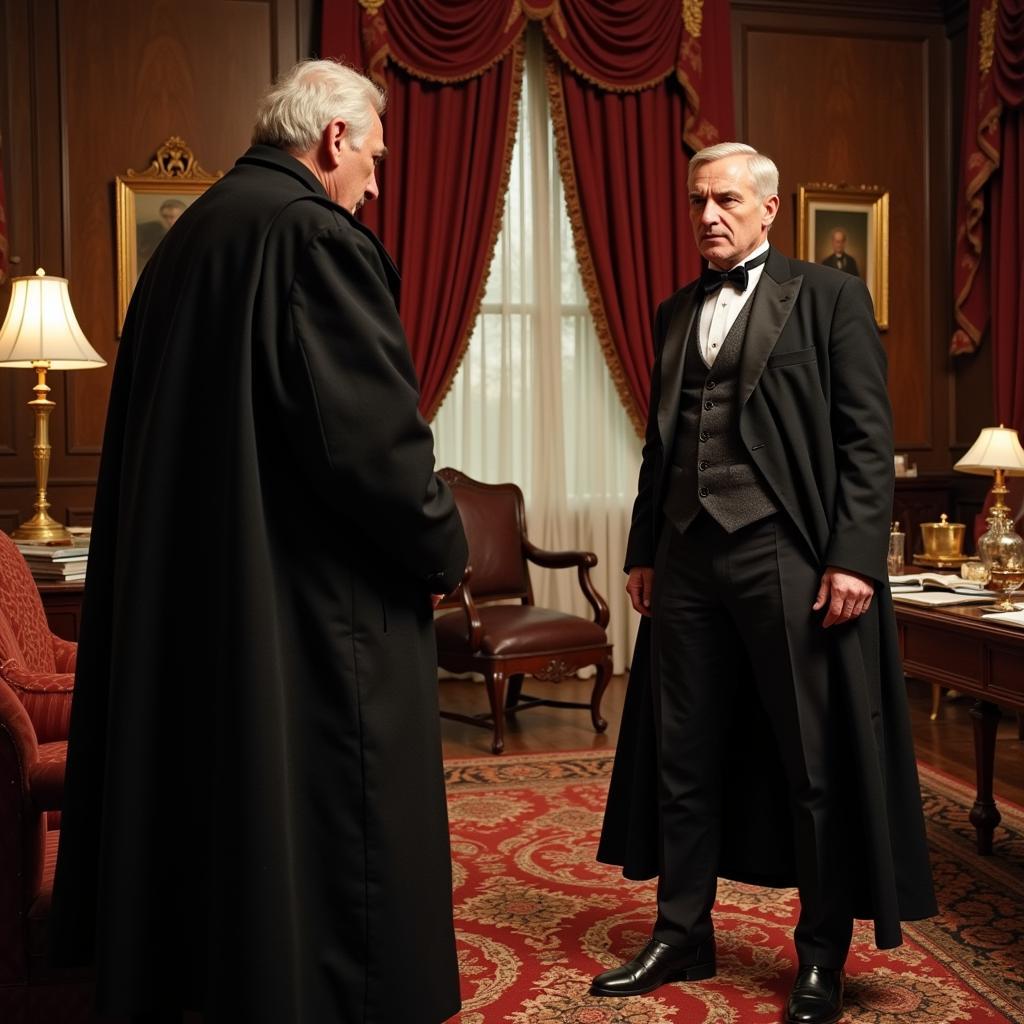Richard Connell’s “The Most Dangerous Game” pits Sanger Rainsford against General Zaroff in a thrilling hunt, but the core conflict transcends the physical chase. It explores the deeper struggle of man vs. society, specifically questioning the value of human life and the consequences of unchecked power.  Rainsford and Zaroff facing off in the jungle, highlighting the tension of the hunt
Rainsford and Zaroff facing off in the jungle, highlighting the tension of the hunt
The Island’s Dark Reflection of Societal Ills
Rainsford, a renowned hunter, finds himself shipwrecked on Ship-Trap Island, ruled by the eccentric General Zaroff. Zaroff, bored with hunting conventional prey, has devised a new, horrifying game: hunting humans. This immediately establishes the central conflict of man vs. society. Zaroff represents a societal structure where the powerful dictate the fate of the vulnerable, mirroring historical injustices and the exploitation of marginalized groups. His aristocratic background and detached demeanor underscore the social commentary on the indifference of the elite towards those they consider beneath them. [man vs society the most dangerous game]
Rainsford’s initial disbelief and disgust reflect the moral compass of a civilized society. He represents the inherent value of human life, a belief that Zaroff’s society rejects. This clash of values highlights the dangerous consequences when societal norms prioritize power over empathy and compassion.
Does Rainsford Become What He Hates?
The game itself forces Rainsford to confront the very principles he initially upheld. As he becomes the hunted, he is pushed to employ the same tactics of survival that he once condemned. This moral ambiguity raises challenging questions. Does fighting for survival justify compromising one’s principles? Does adapting to a brutal society necessitate embracing its inherent cruelty?
 Rainsford setting intricate traps in the jungle, his expression grim and focused.
Rainsford setting intricate traps in the jungle, his expression grim and focused.
Dr. Anya Sharma, a social psychologist, notes, “The ‘Most Dangerous Game’ illustrates how extreme circumstances can blur the lines between right and wrong, forcing individuals to make impossible choices in the face of a corrupt system.” This reinforces the psychological impact of a society built on violence and the moral compromises individuals might make under duress.
The Power of Empathy and the Pursuit of a Just Society
Connell’s narrative also explores the importance of communication in a civil society. The lack of communication and understanding between Zaroff and Rainsford contributes to the conflict. Zaroff’s inability to see Rainsford as anything other than prey reflects a deeper societal problem: the dehumanization of the “other.” This is a recurring theme in societies where prejudice and discrimination thrive. [communication in a civil society]
What Does “The Most Dangerous Game” Teach Us About Society?
“The Most Dangerous Game” acts as a cautionary tale. It demonstrates the potential for human cruelty when societal structures prioritize power over humanity. By highlighting the consequences of unchecked power and the erosion of empathy, Connell’s work calls for a critical examination of our own societies and the values we uphold.
 Rainsford confronting Zaroff in his opulent manor, symbolizing the final confrontation between opposing ideologies.
Rainsford confronting Zaroff in his opulent manor, symbolizing the final confrontation between opposing ideologies.
Professor David Miller, a literary critic, observes, “Connell masterfully uses the hunt as a metaphor for the societal power dynamics that can lead to the dehumanization and oppression of individuals.” The story reminds us that building a truly just and peaceful society requires constant vigilance against such tendencies.
Conclusion: Hunting for Humanity in Our Own World
The conflict of man vs. society in “The Most Dangerous Game” serves as a powerful reminder of the importance of empathy, justice, and the recognition of shared humanity. While Rainsford’s struggle plays out on a remote island, the underlying themes resonate deeply with our own world, urging us to question the systems that allow for the exploitation and marginalization of others. The hunt for true peace requires a constant challenge to these systems and a commitment to building societies where every human life is valued.
FAQ
- What is the main conflict in “The Most Dangerous Game”? (Man vs. society, represented by Rainsford vs. Zaroff and the social system he embodies.)
- What does General Zaroff represent? (The dangers of unchecked power and the dehumanization of others.)
- How does Rainsford’s experience challenge his own beliefs? (He is forced to employ tactics he initially condemned, blurring the lines between right and wrong in the face of survival.)
- What is the significance of Ship-Trap Island? (It represents a microcosm of a society where the powerful prey on the vulnerable.)
- What message does the story convey about society? (It warns against the dangers of prioritizing power over humanity and the importance of empathy and justice.)
- What is the significance of the ending? (It leaves the reader with questions about the lasting impact of the experience on Rainsford and the nature of justice.)
- How does the story relate to real-world issues? (It reflects historical and contemporary examples of social injustice and the exploitation of marginalized groups.)
Do you have other questions or need further information about promoting peace and understanding in today’s world? Explore our related articles on [man vs society the most dangerous game] and [communication in a civil society].
When you need support, please contact Phone Number: 02043854663, Email: [email protected] or visit our address: Khu 34, Bac Giang, 260000, Vietnam. We have a 24/7 customer support team.